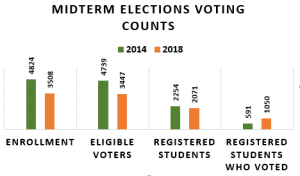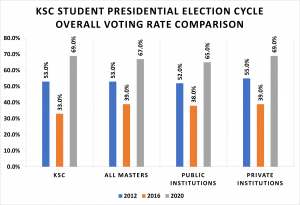STUDENT VOTING AT KEENE STATE COLLEGE
Keene State College has participated in the National Study of Learning, Voting, and Engagement (NSLVE), housed at the Jonathan M. Tisch College of Citizenship and Public Service, Tufts University since 2013. Since NSVLE’s launch in 2013, more than 1,000 colleges and universities have signed up to receive their voting rates for federal elections. Voter registration and voting rates in reports reflect Keene State’s students who were eligible to vote and who voted in elections. The results are based on Keene State’s enrollment records and publicly available voting files collected by Catalist.
The Midterm Elections (2014 compared to 2018)
Review the full report here: NSVLE Keene State 2014 and 2018 Report
As these charts show, that although enrollment at Keene State dipped by 27% between 2014 and 2028,  the rate of students who voted increased by 12.5%. Between 2014 and 2018, Keene State partnered with the Keene City Clerk’s Office to provide voter information and onsite registration. The College also began to offer transportation to the off-campus polling stations and created a celebratory atmosphere for election days. Keene State student consistently vote mainly in person and voting rates increase slightly through their years in college.
the rate of students who voted increased by 12.5%. Between 2014 and 2018, Keene State partnered with the Keene City Clerk’s Office to provide voter information and onsite registration. The College also began to offer transportation to the off-campus polling stations and created a celebratory atmosphere for election days. Keene State student consistently vote mainly in person and voting rates increase slightly through their years in college.



Presidential Elections (2012, 2016, and 2020 Comparisons)
Review the full report here: NSLVE Keene State 2020
Keene State students are engaged in Presidential Elections, the increases over mid-term elections many be partly due to our high percentage of out-of-state students and the excitement generated around the first in nation primary status. Keene State students vote primarily in person in Keene. The overall voting rate has risen to 68.7%, up about 14% since 2012. Keene State students vote at rates higher than the average of other public institutions and Master’s level institutions and at the same rate as private institutions.




